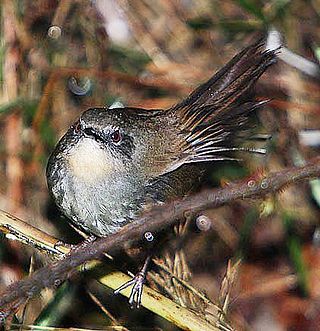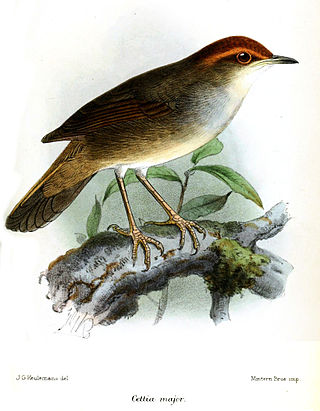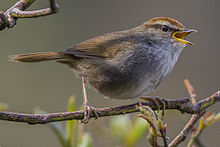
Bush-warblers are small insectivorous songbirds of the genera Cettia, Horornis, and Bradypterus. They were formerly placed in the "wastebin" Old World warbler family. None of the genera as traditionally delimited are believed to be monophyletic.

Cetti's warbler is a small, brown bush-warbler which breeds in southern and central Europe, northwest Africa and the east Palearctic as far as Afghanistan and northwest Pakistan. The sexes are alike. The bird is named after the 18th century Italian zoologist, Francesco Cetti. This species is very difficult to see because of its skulking habits.

Cettia is a genus of small insectivorous songbirds ("warblers") which make up the core of the newly recognized family Cettiidae. They were formerly placed in the Sylviidae, which at that time was a wastebin taxon for the warbler-like Sylvioidea. The range of this genus extends from Europe to southeast Asia.

The Sri Lanka bush warbler, also known as Ceylon bush warbler or Palliser's warbler, is an Old World warbler which is an endemic resident breeder in Sri Lanka, where it is the only bush warbler.

The Japanese bush warbler, known in Japanese as uguisu (鶯), is an Asian passerine bird more often heard than seen. Its distinctive breeding song can be heard throughout much of Japan from the start of spring.
The pale-footed bush warbler is a species of oriental warbler in the family Cettiidae that is found in southern Asia. It occurs in the Himalayan region west from Dehradun through the foothills of Nepal to northeastern India. It also occurs in Myanmar, Laos, northern Vietnam and southern China. A single sighting was recorded from Kandy, Sri Lanka in March 1993.

The chestnut-crowned bush warbler is a species of warbler found in South Asia. Although overall population size has not been quantified, this is one of the species that is declining due to habitat destruction. Although its population trend is observed to be decreasing, its decline is not happening in rapid fashion. For this reason, this is evaluated as least concern species.
The Bougainville bush warbler or odedi is a bird species initially placed in the "Old World warbler" assemblage, but nowadays moved with its congeners to the new cettiid warbler family.

The Taiwan bush warbler is a species of Old World warbler in the family Locustellidae. It is found only in Taiwan. Its natural habitat is undergrowth and grassland 1,200–3,000 m (3,900–9,800 ft) in elevation. It was first recorded in 1917 and named as a distinct species in 2000. The International Union for Conservation of Nature (IUCN) has assessed it as a least-concern species.

The Manchurian bush warbler, also known as Korean bush warbler, is a bird in the family Cettiidae. The species was first described by Robert Swinhoe in 1860. It is found in northeastern China.

The chestnut-headed tesia is a small insectivorous songbird formerly of the "Old World warbler" family but nowadays placed in the bush warbler family (Cettiidae).

The tesias are a genus, Tesia, of Old World warbler. Though once included in the large family Sylviidae, more recent research placed it within a new family, Cettiidae. The four species inhabit undergrowth of montane forest in South and Southeast Asia, where they are resident or short-range migrants. They have longish legs and appear tailless, with (seemingly) only 8 rectrices. Their simple songs are fairly loud, and their nests are typically ball-shaped. Their name is derived from Tisi, the Nepalese name for the grey-bellied tesia.

The Bornean stubtail is a species of bird in the cettiid warbler family Cettiidae. It is endemic to the island of Borneo, where it inhabits forest floors and undergrowth in montane forests at elevations of 750–3,150 m (2,460–10,330 ft). It is a small, short-tailed warbler, measuring 9.5–10 cm (3.7–3.9 in) in length and having an average mass of 10.4 g (0.37 oz). The tops of the head and the upperparts are brown, with whitish underparts that turn grey at the sides of the breast and the flanks. The supercilium is long and buffish-brown, with an equally long dark grey eyestripe and a thin yellow eye-ring. Both sexes are similar.

Cettiidae is a newly validated family of small insectivorous songbirds ("warblers"), formerly placed in the Old World warbler "wastebin" assemblage. It contains the typical bush warblers (Cettia) and their relatives. As a common name, cettiid warblers is usually used.

Locustellidae is a newly recognized family of small insectivorous songbirds ("warblers"), formerly placed in the Old World warbler "wastebin" family. It contains the grass warblers, grassbirds, and the Bradypterus "bush warblers". These birds occur mainly in Eurasia, Africa, and the Australian region. The family name is sometimes given as Megaluridae, but Locustellidae has priority.

The Baikal bush warbler, also known as Baikal grasshopper-warbler or David's bush warbler, is a migratory species of Old World warbler in the family Locustellidae.

Hume's bush warbler is a species of bush warbler. It was formerly included in the "Old World warbler" assemblage.

Horornis is a genus of small insectivorous songbirds ("warblers") which make up the core of the newly recognized family Cettiidae. They were formerly placed in the Sylviidae, which at that time was a wastebin taxon for the warbler-like Sylvioidea. The range of this genus occurs from southeast Asia throughout the western Pacific. The most recently described species is the Bougainville bush warbler from Bougainville Island.















